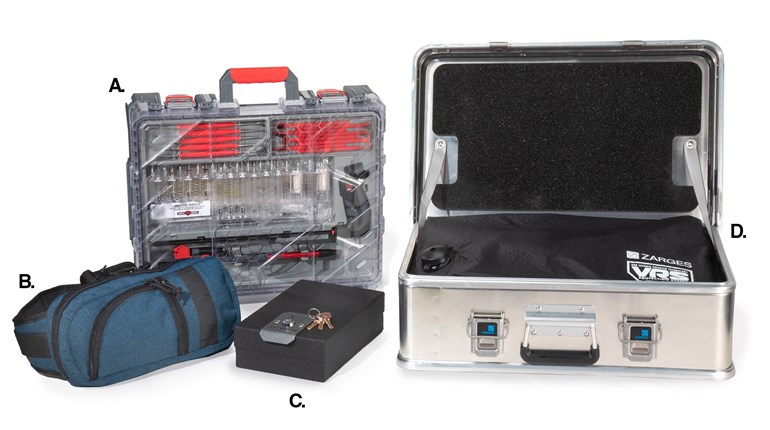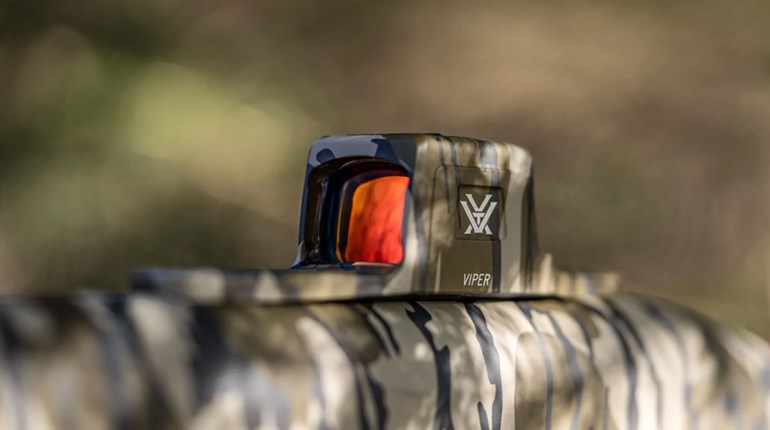
You don’t shoot for long without realizing the futility of trying to do every shooting “job” with a single firearm. Even for purely sporting purposes this is hard to do, and just plain silly to try for serious work like self-defense, freezer-stocking or duty.
We’d make the same observation about optics. Choices have burgeoned in the last 10 years, with niches filled and compromises dashed. Two particularly clever examples draw our eye at present.
Vortex Spitfire
Encountering a Vortex optic these days, and especially if you meet us at the range. We’ve used a bunch with unexpected (and now entirely expected) success, and the folks from Middleton, Wis., don’t disappoint with their Spitfire Prism scopes either.
The optical configuration behind this whole class of scopes remains confusing for some, but they aren’t conceptually difficult. Mainly, a prism-style riflescope is designed to let a scope of “X” magnification trade substantially decreased length for slightly increased girth. This happens by “folding” the incoming light path prismatically.
In practice, they’ve also proven to be very tough, though we can never decide why: Are they simply a smaller target for the vicissitudes of the field, or actually more durable than conventional “tubes?” We’re not convinced it matters.

What we can say is that our Spitfire 3x has performed from the very first shot. The EBR-556B reticle even up-calibered with no trouble: The handy rifle when the Spit’ came in was actually a Windham WeaponryR18FSFST in .308/7.62x51. Suffice it to say we have yet to miss with this combination out to 200 yards, even off hand. On the rail, magazine in, charge, sight, boom, ding—just that easy.
When we moved out to 300 yards, the fact that the rifle had never been properly zeroed finally showed, but a little adjustment put us back on our MGM 2/3-sized reactive silhouette in no time. Here, we thought the reticle was a huge help. 3x may not sound like much, but the inverted, interrupted horseshoe (18.85 MOA diameter) reticle framed targets extremely well. For longer engagements, the reticle has drop compensation markings for 300, 400 and 500 yards, with decreasing subtensions so they can be used for ranging as well. It’s lighted, of course, in red or green, and no zero shift from -22 to +122° F.
Straight from Vortex, your “in the box” kit is complete. Picatinny rail(s) and riser make a host of possible mounts easy (appropriate hex wrenches are included), and a CR2032 battery and lens covers mean you can do as we did: out of the packaging, on to the rifle, etc.
We close with a confession: This is working so well on the Windham, we’ve yet to put this on a correct rifle, that is, a .223/5.56. This is our excuse for keeping it well past the normal review window.
Contact Vortex Optics at http://www.vortexoptics.com/.
Burris 2-7x32 mm LER
Now and then, it’s fun to take a look back and be able to say “Huh. Got that one right.” That’s how we feel about this (dandy!) Burris.
We’ve been fans of this scope for a long time, and have a vintage copy to prove it. What’s amusing, at least, and interesting, perhaps, is that it was originally a handgun scope. Ours, however, has never lived anywhere but forward mounted on a .308 Winchester rifle.

Perhaps obviously, we must be talking about a “Scout” rifle, or at least a configuration along those lines. Here, a little background helps: Another of the great Jeff Cooper’s contributions to shooting and hunting, at the time it was also his most controversial. In the short version, Cooper posited the standard for a truly general-purpose rifle, suitable for the vast bulk of rifle tasks but especially practical hunting (animals up to 1,000 pounds) and defense. At the time (the early ’80s) few argued with his caliber preference (the widely available .308 Winchester), weight range (7-ish pounds) or length (under a meter). It bespoke a handy, shootable rifle fitting for a huge percentage of riflemen and women.
For the most part, critics (wisely) kept their mouths shut until Cooper specified the sighting technology. His preference was for a low-magnification, forward-mounted scope and back-up iron sights. Then, however: the howling! As was his way, Cooper stuck to his, er, guns, and relatively patiently demonstrated the many benefits of such a combination—better situational awareness due to less/no compromise of peripheral vision (remember, low magnification allows both eyes to remain open), no chance of a “scope cut” over the eye, and keeping the action area wide open for clearing and/or loading.
But the icing on the cake (and just our opinion) was Cooper’s ability to take and hit “wing” shots with a scoped, centerfire rifle, and to further demonstrate that others could do so as well. Even not-so-accomplished wing shots like we managed it. Clearly, some good things could happen with a Cooper Scout and the correct optic. Burris was there early, and had a brilliantly clear, trim fixed-power scope for those early Scouts.
“The rest is history,” or so the saying goes, with at least five current manufacturers offering Cooper-spec Scouts. Certainly the Colonel’s vision has been vindicated—again.
The next logical step always seemed—at least to us—to be a variable scope within the paradigm. For years, our Burris was the only one we could find, albeit marked for handgun use. And use it, we did.

We love our vintage version, but Burris loaned us one of their new versions too when a Mossberg MVP Scout recently appeared on the doorstep. We won’t be coy: We’re even more enamored of the “modern” 2-7x. While the optic parameters don’t seem meaningfully different than our original, several other things are clearly better. For one, the adjustment and diopter locking rings have a better texture for manipulation in the field, especially with gloves on.
Both old and new 2-7xs have the “Ballistic Plex” reticle, which makes holdovers at considerable range a snap for any cartridge and load (distances will vary off the standard 300, 400 and 500 yards for any particular cartridge, but they’ll still be marked). Great, as far as it goes, but we’d have to say the new one is “crisper” than our original (guess who’ll be taking advantage of the Burris “Forever Warranty” in a heck of a hurry if anything goes wrong). That said, it’s still a great advance to be able to zoom out to 7x, and take those 500-yard shots with the confidence that clear target visualization brings. (Even Col. Cooper acknowledged this, quipping to the effect that, “Magnification doesn’t help you shoot better, but it does help you see better.”)
Best, though, is how the variable gives back that distant sight picture while still capturing the rapid acquisition benefits that Col. Cooper so rightly championed. And while there’s no question that his original fixed-power (2.75x) is ever so slightly brighter—its smaller lens count dictates that it must be unless glass quality is different—the variable still has the marvelously roomy eye box that long eye relief brings to the table.
So with a good backstop, shoot those thrown clays at 2x, just as Col. Cooper did. But nail down that 500-yard meat-in-freezer shot, too.
Contact Burris at http://www.burrisoptics.com/.


































